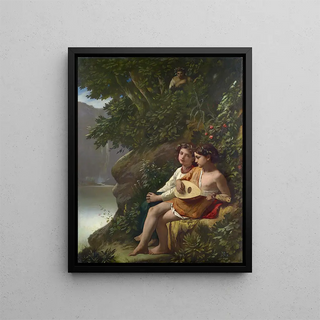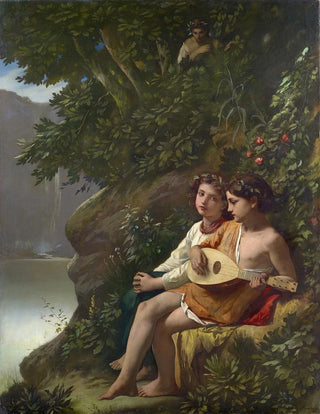Painting of children making music heard by a nymph - Anselm Feuerbach | Art print


View from behind

Frame (optional)
In the rich and complex universe of art history, certain works manage to capture the very essence of childhood and beauty. The art print of "Children Making Music Heard by a Nymph" by Anselm Feuerbach is a striking example. This piece, evoking a delicate and poetic scene, immerses the viewer in a world where music and nature intertwine harmoniously. The children, central figures of the composition, seem to play a melody that transcends the boundaries of the visible, attracting the attention of an ethereal nymph. This interaction between juvenile innocence and divine grace creates a dreamlike atmosphere, where time appears suspended, inviting deep contemplation.
Style and uniqueness of the work
Feuerbach, master of light and color, uses a vibrant palette to breathe life into this scene. Pastel shades, combined with brighter touches, evoke a joyful and serene atmosphere. The faces of the children, filled with touching expressiveness, demonstrate an exceptional skill in capturing human emotions. The composition, carefully arranged, directs the gaze toward the nymph, the central figure embodying idealized beauty. The meticulous details, from musical instruments to lush foliage, reveal a particular attention to nature, an essential element of the work. This fusion between human and natural elements is a distinctive characteristic of Feuerbach, who manages to create a visual harmony where each element finds its place in perfect balance.
The artist and his influence
Anselm Feuerbach, an emblematic figure of the 19th century, established himself as a pioneer in the German artistic movement. Influenced by the great masters of the Renaissance and Baroque, he reinterpreted these styles with a modern sensitivity. His ability to marry mythology and reality, while incorporating universal themes such as love, nature, and childhood, profoundly marked his contemporaries. Feuerbach also played a key role in the transition between Romanticism and Realism, paving the way for new artistic explorations.

Matte finish

View from behind

Frame (optional)
In the rich and complex universe of art history, certain works manage to capture the very essence of childhood and beauty. The art print of "Children Making Music Heard by a Nymph" by Anselm Feuerbach is a striking example. This piece, evoking a delicate and poetic scene, immerses the viewer in a world where music and nature intertwine harmoniously. The children, central figures of the composition, seem to play a melody that transcends the boundaries of the visible, attracting the attention of an ethereal nymph. This interaction between juvenile innocence and divine grace creates a dreamlike atmosphere, where time appears suspended, inviting deep contemplation.
Style and uniqueness of the work
Feuerbach, master of light and color, uses a vibrant palette to breathe life into this scene. Pastel shades, combined with brighter touches, evoke a joyful and serene atmosphere. The faces of the children, filled with touching expressiveness, demonstrate an exceptional skill in capturing human emotions. The composition, carefully arranged, directs the gaze toward the nymph, the central figure embodying idealized beauty. The meticulous details, from musical instruments to lush foliage, reveal a particular attention to nature, an essential element of the work. This fusion between human and natural elements is a distinctive characteristic of Feuerbach, who manages to create a visual harmony where each element finds its place in perfect balance.
The artist and his influence
Anselm Feuerbach, an emblematic figure of the 19th century, established himself as a pioneer in the German artistic movement. Influenced by the great masters of the Renaissance and Baroque, he reinterpreted these styles with a modern sensitivity. His ability to marry mythology and reality, while incorporating universal themes such as love, nature, and childhood, profoundly marked his contemporaries. Feuerbach also played a key role in the transition between Romanticism and Realism, paving the way for new artistic explorations.
12,34 €






